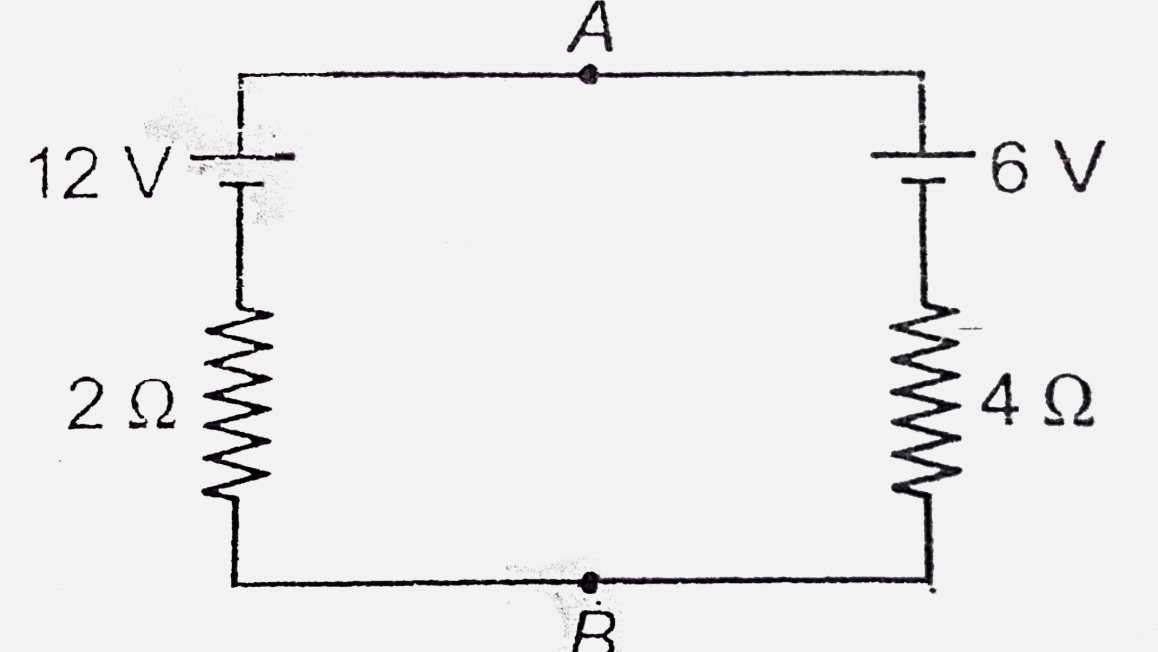The work done against electric in increasing the potential difference of a condenser from 20 V to 40 V is W. The work done in increasing its potential difference from 40 V to 50 V will be
4W
3W4
2W
W2
The correct Answer is:C
To solve the problem, we need to calculate the work done in two different scenarios of increasing the potential difference across a capacitor (or condenser).
1. Understanding the Work Done Formula:
The work done (W) in charging a capacitor when the potential difference is increased from V1 to V2 is given by the formula:
W=12C(V22−V21)
where C is the capacitance of the capacitor.
2. Calculating Work Done from 20V to 40V:
In the first case, we increase the potential difference from V1=20V to V2=40V:
W=12C(402−202)
=12C(1600−400)=12C(1200)=600C
We are given that this work done is W. Therefore, we can equate:
W=600C(Equation 1)
3. Calculating Work Done from 40V to 50V:
In the second case, we increase the potential difference from V1=40V to V2=50V:
W′=12C(502−402)
=12C(2500−1600)=12C(900)=450C
4. Relating the Two Work Done Values:
We can express C in terms of W from Equation 1:
C=W600
Now substituting this into the expression for W′:
W′=450C=450(W600)=450W600=3W4
5. Conclusion:
Therefore, the work done in increasing the potential difference from 40V to 50V is:
W′=3W4
Final Answer:
The work done in increasing the potential difference from 40V to 50V will be 3W4.
---
The work done (W) in charging a capacitor when the potential difference is increased from V1 to V2 is given by the formula:
W=12C(V22−V21)
where C is the capacitance of the capacitor.
In the first case, we increase the potential difference from V1=20V to V2=40V:
W=12C(402−202)
=12C(1600−400)=12C(1200)=600C
We are given that this work done is W. Therefore, we can equate:
W=600C(Equation 1)
In the second case, we increase the potential difference from V1=40V to V2=50V:
W′=12C(502−402)
=12C(2500−1600)=12C(900)=450C
We can express C in terms of W from Equation 1:
C=W600
Now substituting this into the expression for W′:
W′=450C=450(W600)=450W600=3W4
Therefore, the work done in increasing the potential difference from 40V to 50V is:
W′=3W4
The work done in increasing the potential difference from 40V to 50V will be 3W4.
Topper's Solved these Questions
- BOOK - DC PANDEY ENGLISHCHAPTER - ELECTROSTATICSEXERCISE - JEE Advanced44videos
ELECTROSTATICS
- BOOK - DC PANDEY ENGLISHCHAPTER - ELECTROSTATICSEXERCISE - Comprehension36videos
ELECTROSTATICS
- BOOK - DC PANDEY ENGLISHCHAPTER - ELASTICITYEXERCISE - Medical entrances s gallery21videos
ELASTICITY
- BOOK - DC PANDEY ENGLISHCHAPTER - EXPERIMENTSEXERCISE - Subjective15videos
EXPERIMENTS
Similar Questions
The work done in increasing the potential of a capacitor from V volt to 2V volt is W Then, the work done in increasing the potential of the same capacitor from 2V volt to 4V volt will be.
View SolutionThe amount of work done in increasing the voltage across the plates of capacitor from 5 V to 10 V is W. The work done in increasing it from 10 V to 15 V will be
View SolutionThe work done in increasing the P.D. across the plates of a capacitor from 4V to 6V is W then work done in increasing the P.D. from 6V to 8V is
View SolutionAn electron is accelerated from rest through a potential difference V. This electron experiences a force F in a uniform magnetic field. On increasing the potential difference to V', the force experienced by the electron in the same magnetic field becomes 2F. Then, the ratio (V'/V) is equal to
View SolutionA truck accelerates from speed v to 2v. Work done in during this is
View SolutionConsider
 .
.
The potential difference VA−VB is.View SolutionIn which of the following cases can the work done increase the potential energy?
View SolutionPotential difference across AB , i.e., VA−VB is
 View Solution
View SolutionTwo, capacitors A and B are connected in series across a 100V supply and it is observed that the potential difference across them are 60V and 40V. A capacitor of 2pF capacitance is now connected in parallel with A and the potential difference across B rises to 90V. Determine the capacitance of A and B
View SolutionIf the potential of a capacitor having capacity of 6μF is increased from 10 V to 20 V,then increase in its energy will be
View Solution

